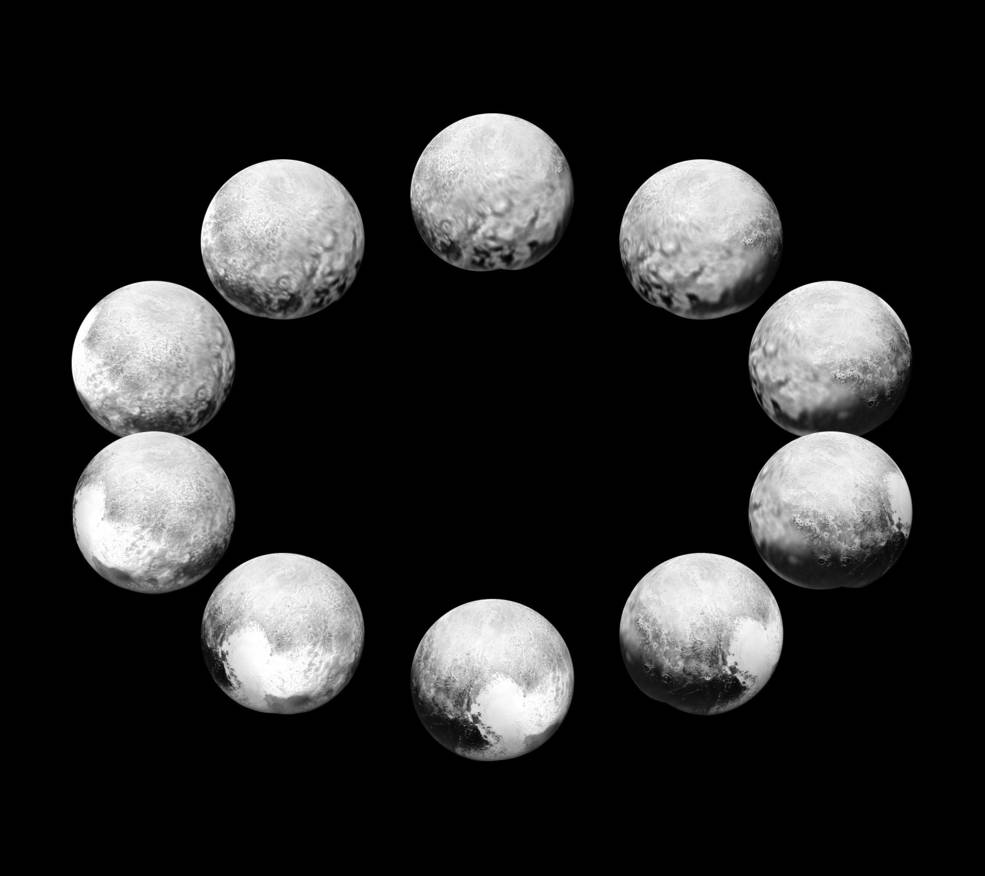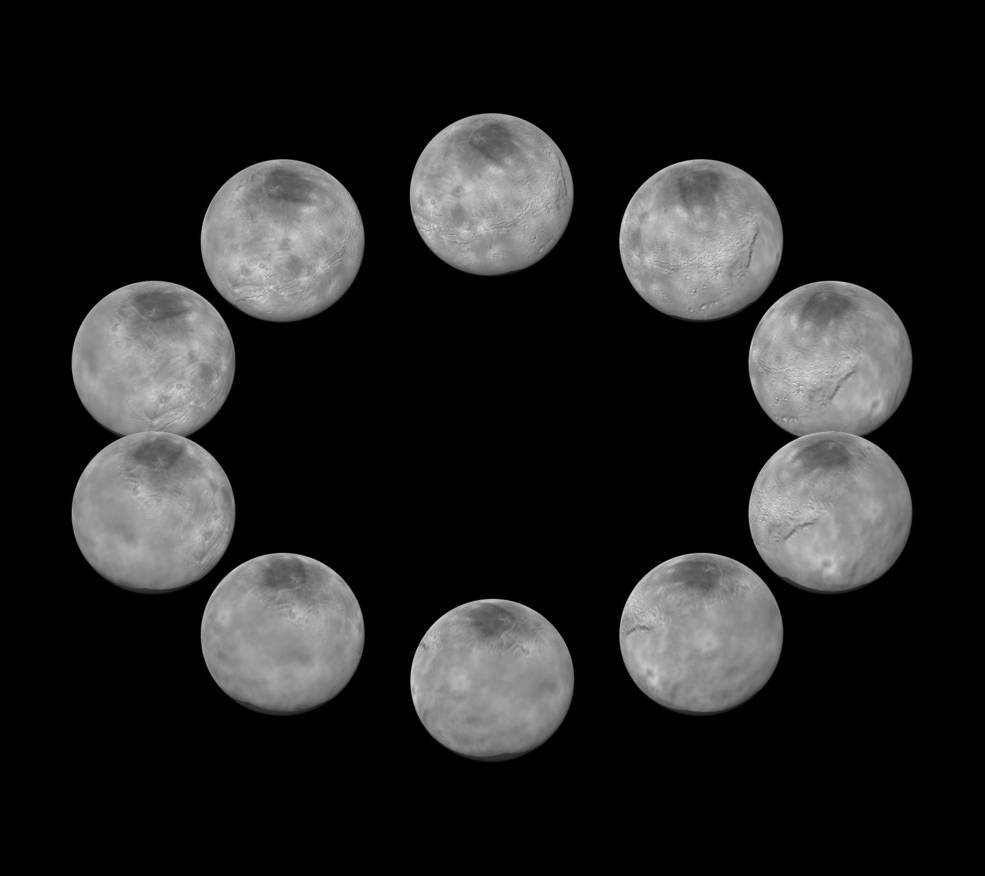It looks like you're using an Ad Blocker.
Please white-list or disable AboveTopSecret.com in your ad-blocking tool.
Thank you.
Some features of ATS will be disabled while you continue to use an ad-blocker.
6
share:

WOW!!! Did you know one day on Pluto is equivalent to 156 Earth hours. I didn't know that. Pretty cool IMO. Puts "Interstellar" into a bit more perspective. The Long Range Reconnaissance Imager and the Ralp/Multispectral Visible Imagine Camera, or just know as Ralph, has brought a some pretty amazing pictures.
The images were taken by the Long Range Reconnaissance Imager (LORRI) and the Ralph/Multispectral Visible Imaging Camera as the distance between New Horizons and Pluto decreased from 5 million miles (8 million kilometers) on July 7 to 400,000 miles (about 645,000 kilometers) on July 13. The more distant images contribute to the view at the 3 o’clock position, with the top of the heart-shaped, informally named Tombaugh Regio slipping out of view, giving way to the side of Pluto that was facing away from New Horizons during closest approach on July 14. The side New Horizons saw in most detail – what the mission team calls the “encounter hemisphere” – is at the 6 o’clock position.
NASA Sauce

A day on Charon, the largest moon around Pluto, is one hour shorter.
These images and others like them reveal many details about Charon, including how similar looking the encounter hemisphere is to the so-called “far side” hemisphere seen only at low resolution – which is the opposite of the situation at Pluto. Dimples in the bottom (south) edge of Charon’s disk are artifacts of the way the New Horizons images were combined to create these composites.
Did they find the Alien base yet?
Now that they've imaged Pluto, the odds it is somewhere within the solar system are dwindling.
Where are they planning missions to return to?
Besides looking for water, like Europa, I mean.
Now that they've imaged Pluto, the odds it is somewhere within the solar system are dwindling.
Where are they planning missions to return to?
Besides looking for water, like Europa, I mean.
a reply to: TheAmazingYeti
That's interesting that their days are only 1 hour difference. I assume that it must be their shared orbits around each other and their near identical sizes that makes their rotations so close. Of interest is also Earth's moon, a day on Earth's moon is equal to the length of the orbit around Earth, and this makes Earth's moon always facing an unchanging side towards Earth.
That's interesting that their days are only 1 hour difference. I assume that it must be their shared orbits around each other and their near identical sizes that makes their rotations so close. Of interest is also Earth's moon, a day on Earth's moon is equal to the length of the orbit around Earth, and this makes Earth's moon always facing an unchanging side towards Earth.
With the Earth/Moon system, the Moon is gravitationally locked to the Earth, due to it's center of mass being offset towards Earth. I wonder if this
is happening with Pluto and Charon. Will they eventually become sychronised together?
a reply to: stormcell
According to these links the two are tidally locked.
www.google.com...=pluto+and+its+largest+moon+charon+are+tidally+locked+to+each+other" target="_blank" class="postlink" rel="nofollow">google search results
According to these links the two are tidally locked.
www.google.com...=pluto+and+its+largest+moon+charon+are+tidally+locked+to+each+other" target="_blank" class="postlink" rel="nofollow">google search results
Pluto and Charon are tidally locked to each other; they "dance around" the common point in space between them, always showing the same side to each
other.
new topics
-
How To Spot Fake U.F.O. Photos
Aliens and UFOs: 6 hours ago -
Scary video of face in an abandoned house
Paranormal Studies: 8 hours ago -
Just Came Across These Unusual Old UFO Pics
Aliens and UFOs: 10 hours ago -
LA Mayor Bass Demanded $49M in Additional LAFD Cuts One Week Before Wildfires
Mainstream News: 11 hours ago
top topics
-
LA Mayor Bass Demanded $49M in Additional LAFD Cuts One Week Before Wildfires
Mainstream News: 11 hours ago, 17 flags -
Just Came Across These Unusual Old UFO Pics
Aliens and UFOs: 10 hours ago, 7 flags -
Scary video of face in an abandoned house
Paranormal Studies: 8 hours ago, 5 flags -
How To Spot Fake U.F.O. Photos
Aliens and UFOs: 6 hours ago, 4 flags -
Carry On!
Short Stories: 13 hours ago, 3 flags -
Sepultura - Territory - With New Drummer Greyson Nekrutman
Music: 13 hours ago, 2 flags
active topics
-
Los Angeles brush fires latest: 2 blazes threaten structures, prompt evacuations
Mainstream News • 392 • : AlroyFarms -
Archbisop Vigano Warns of Deep State and Deep Church
New World Order • 10 • : McGinty -
How To Spot Fake U.F.O. Photos
Aliens and UFOs • 3 • : Station27 -
Judge rules president-elect Donald Trump must be sentenced in 'hush money' trial
US Political Madness • 121 • : WeMustCare -
Candidate TRUMP Now Has Crazy Judge JUAN MERCHAN After Him - The Stormy Daniels Hush-Money Case.
Political Conspiracies • 2191 • : WeMustCare -
A Flash of Beauty: Bigfoot Revealed ( documentary )
Cryptozoology • 13 • : SteamyAmerican -
FBI Says IRAN is Trying to Kill Candidate TRUMP - But UKRAINE May Be a Greater Danger.
2024 Elections • 15 • : WeMustCare -
-@TH3WH17ERABB17- -Q- ---TIME TO SHOW THE WORLD--- -Part- --44--
Dissecting Disinformation • 3989 • : WeMustCare -
Old School Punk
Music • 566 • : underpass61 -
To become president, Zelensky had to learn Ukrainian
Political Conspiracies • 44 • : SteamyAmerican
6
